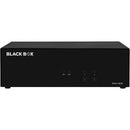Description
Discover the Black Box Secure KVM Switch DVI-I, an enterprise-grade, rugged solution engineered for mission-critical environments where data protection, reliability, and precise control are non-negotiable. This secure KVM switch enables administrators to manage multiple computers from a single console while prioritizing hardware-based isolation, secure operation, and seamless performance. Built to withstand demanding defense applications, secure control rooms, corporate data centers, and facilities that rely on digital and analog displays, it preserves high video quality and input responsiveness without compromising security. Designed to integrate smoothly into existing security and IT architectures, it simplifies workflows, reduces risk, and ensures tight control over access to sensitive systems in environments ranging from financial institutions to healthcare facilities and industrial facilities.
- Security-first hardware design: Engineered to minimize data exposure with isolated channels for each connected host, enforcing secure access and centralized control to support defense-grade operations and secure data centers.
- DVI-I compatibility for digital and analog displays: Supports both digital and analog video signals, enabling connections to a wide range of monitors and projectors and facilitating seamless transitions from legacy displays to modern screens.
- Rugged, 24/7 reliability: Built with robust materials and precise engineering to maintain uptime in demanding environments, ensuring dependable performance under varying ambient conditions.
- Easy, low-latency multi-host switching: Provides quick, reliable transitions between connected computers with minimal video latency, preserving image quality and input responsiveness during critical management tasks.
- Seamless integration with existing security and IT ecosystems: Works with standard console peripherals and aligns with established security architectures and workflow pipelines for straightforward deployment at scale.
Technical Details of Black Box Secure KVM Switch DVI-I Enterprise Grade For Digital Analog Displays With Rugged Design And Multi Host Isolation Monitor
- Video interface: DVI-I support enabling both digital and analog display connections, suitable for mixed environments and legacy equipment.
- Host connectivity: Designed to manage multiple host computers from a single console with hardware-based isolation to prevent cross-system data leakage.
- Security and isolation: Hardware-focused security features deliver strict access control and multi-host isolation to protect sensitive workloads in secure facilities.
- Console management: Centralized control from a single console with straightforward switching methods. Supports intuitive front-panel operations and efficient keyboard/mouse interaction.
- Video quality and performance: Maintains high video fidelity with minimal latency, ensuring reliable monitoring and precise control during critical operations.
- Rugged design for demanding environments: Built to endure continuous operation in challenging conditions, contributing to long-term uptime in control rooms, data centers, and industrial settings.
- Compatibility and integration: Compatible with standard console peripherals and IT security infrastructures, enabling smooth integration into existing setups without extensive reconfiguration.
How to Install Black Box Secure KVM Switch DVI-I
- Plan your installation in a secure area, aligning the switch with your control desk or rack space and ensuring adequate ventilation and cable management to prevent overheating and interference.
- Connect each host computer to the KVM switch’s input ports using appropriate KVM cables for video (DVI-I), keyboard, and mouse connections. Ensure tight, secure connections to minimize signal loss and latency.
- Attach your console devices (keyboard, video monitor, mouse) to the switch’s dedicated console port or designated console connections. Verify that the console is compatible with the switch’s input/output configuration.
- Power on the KVM switch first, then power up each connected host in sequence. If the device offers a firmware or security policy setup, perform those steps before full operation.
- Configure the preferred switching method (front-panel controls, hotkeys, or On-Screen Display if available) and set any security policies, user access levels, or audit logging options provided by the device.
- Test the setup by switching between hosts, confirming video integrity, input recognition, and secure isolation per your organization’s security requirements. Make adjustments to timing, latency settings, or display configuration as needed.
- Document the configuration, update firmware if necessary, and implement routine maintenance checks to preserve security, performance, and reliability over time.
Frequently asked questions
-
Q: What display types does this KVM switch support?
A: It supports DVI-I video signals, enabling connections to both digital and analog displays, which is ideal for mixed environments with legacy monitors and modern screens. -
Q: How many computers can I connect to this switch?
A: The description emphasizes multi-host isolation and centralized control from a single console, but the exact number of supported hosts is not specified here. It is designed for environments needing secure, multi-host management from one console. -
Q: Is the device suitable for 24/7 operation?
A: Yes. The rugged design and engineering are geared toward continuous operation in demanding control rooms, data centers, and industrial facilities. -
Q: Does it require software to operate?
A: No. The KVM switch provides hardware-based secure switching and uses standard console peripherals, minimizing software dependencies. -
Q: Can this switch integrate with existing security architectures?
A: Yes. It is designed to slot into established security and IT ecosystems and workflows, helping organizations maintain centralized control without extensive reconfiguration. -
Q: What measures help prevent data leakage?
A: The device uses hardware-enforced isolation between connected hosts and a secure management path, reducing the risk of cross-system data exposure during operations.
Customer reviews
Showing - Of Reviews


